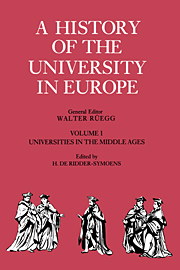Book contents
- Frontmatter
- Contents
- List of maps
- Contributors and editors
- Reader's guide
- Bibliographical abbreviations used in notes
- FOREWORD
- Acknowledgements
- PART I THEMES AND PATTERNS
- PART II STRUCTURES
- PART III STUDENTS
- PART IV LEARNING
- THE FACULTY OF ARTS
- CHAPTER 10.1 THE TRIVIUM AND THE THREE PHILOSOPHIES
- CHAPTER 10.2 THE QUADRIVIUM
- CHAPTER 11 THE FACULTY OF MEDICINE
- CHAPTER 12 THE FACULTIES OF LAW
- CHAPTER 13 THE FACULTY OF THEOLOGY
- EPILOGUE
- Editors' note on the indexes
- Name index
- Geographical and subject index
CHAPTER 13 - THE FACULTY OF THEOLOGY
- Frontmatter
- Contents
- List of maps
- Contributors and editors
- Reader's guide
- Bibliographical abbreviations used in notes
- FOREWORD
- Acknowledgements
- PART I THEMES AND PATTERNS
- PART II STRUCTURES
- PART III STUDENTS
- PART IV LEARNING
- THE FACULTY OF ARTS
- CHAPTER 10.1 THE TRIVIUM AND THE THREE PHILOSOPHIES
- CHAPTER 10.2 THE QUADRIVIUM
- CHAPTER 11 THE FACULTY OF MEDICINE
- CHAPTER 12 THE FACULTIES OF LAW
- CHAPTER 13 THE FACULTY OF THEOLOGY
- EPILOGUE
- Editors' note on the indexes
- Name index
- Geographical and subject index
Summary
From biblical exegesis towards scholastic theology
One of the main characteristics of medieval university teaching was the stability of a set of doctrinal textbooks such as those of Aristotle in the faculty of arts, of Justinian in the faculty of law, and of Galen in the faculty of medicine. For theology the authority was the Bible, but its lack of doctrinal coherence made it insufficient as a textbook alone. It needed interpretation, and from the beginning of the Christian era theology was essentially the exegesis of sacred Scripture, hence its name sacra pagina.
This hermeneutic activity had been carried on since antiquity by the fathers of the church and by monks in the monasteries, the centres of learning before the rise of the universities. A most important patristic contribution which influenced all later medieval exegesis was Saint Augustine's (d. 430) De doctrina christiana. The first three books contain rules for interpreting Scripture, while book four is a treatise on how to preach the doctrine built up by the methods established in the previous books. Saint Augustine vindicates the pagan liberal arts and moral precepts on the grounds that they rightly belong to those who preach the gospel. The insistence on the usefulness of secular learning for Christian speculation, at least on a moderate scale, is only to be expected in one who, like Saint Augustine, was well trained in Roman rhetoric and spent his youth reading Virgil and Cicero.
- Type
- Chapter
- Information
- A History of the University in Europe , pp. 409 - 441Publisher: Cambridge University PressPrint publication year: 1991
- 4
- Cited by



